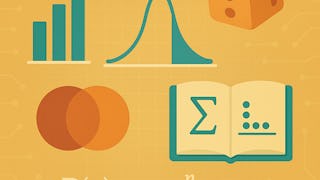Welcome to Engineering Probability and Statistics Part 1. Throughout your time in this course, you will be given opportunities to check your understanding of course material, as well as engage in quizzes to reflect on all the concepts you have explored within each module. By the end of this part 1 course on engineering probability and statistics, you will have a foundational understanding of the fundamentals of statistics, probability, variables, and types of distributions.
通过 Coursera Plus 解锁访问 10,000 多门课程。开始 7 天免费试用。
您将获得的技能
要了解的详细信息

添加到您的领英档案
July 2025
17 项作业
了解顶级公司的员工如何掌握热门技能

该课程共有7个模块
Welcome to your first step into the world of statistics! This module isn't just about numbers—it's about discovering how data can help us make smarter decisions, solve problems, and improve processes. While it may not be apparent, statistics impacts everyday life, and it plays a major role in engineering, from predicting trends to optimizing systems. In this module, you'll explore key ideas such as statistical thinking, understanding variability, and distinguishing between populations and samples. You'll also get hands-on experience with exploratory data analysis (EDA), where you'll learn how to collect, summarize, and visualize data to find meaningful patterns and uncover insights. By the end of this module, you'll have a strong foundation in statistical reasoning, setting you up for success in the rest of the course. So, let's get started and see how statistics can help you make sense of the world around you.
涵盖的内容
4个视频28篇阅读材料4个作业
Probability is all about understanding uncertainty and making informed decisions. Every day, we encounter situations where the result is unknown—whether it’s predicting the weather or playing a game of chance. In this module, you will learn the basics of probability, including how to define experiments, sample spaces, and events. You will also learn the difference between simple and compound events. A few key rules help us calculate and understand probabilities effectively. You will learn how to apply the complement, addition, and multiplication rules to calculate the likelihood of different events. We will also discuss conditional probability and independence so you can determine if events are related or completely independent. Counting principles such as permutations and combinations will also help you determine the number of possible outcomes in various scenarios. Finally, we’ll introduce Bayes’ Theorem, which is a powerful tool for updating probabilities as new information becomes available. By the end of this module, you will be able to define probability concepts, apply key probability rules, analyze conditional probability, use counting principles, and apply Bayes' Theorem to make data-driven decisions.
涵盖的内容
2个视频16篇阅读材料2个作业
In this module, we’ll cover some of the most fundamental concepts in statistics: random variables and probability distributions. These concepts enable us to mathematically model previously discussed probability-based scenarios. Specifically, you’ll learn how random variables act like the link between probability theory and analytics. We’ll also take a look at the difference between discrete and continuous random variables and examine some types of probability distributions.
涵盖的内容
6篇阅读材料2个作业
In this module, we’ll explore some important discrete probability distributions that help us model real-world randomness. These distributions provide a structured way to analyze uncertainty in everyday scenarios, from predicting defective products in manufacturing to estimating customer arrivals at a service center. We’ll cover the Binomial, Negative Binomial, Hypergeometric, and Poisson distributions. You'll learn how to choose the right distribution for the right scenario, model complex situations, and understand the fascinating Poisson process, which governs time-dependent events such as traffic flow and server requests. By the end of this module, you'll be equipped with the skills to analyze, model, and interpret discrete probability distributions, turning theoretical concepts into practical insights!
涵盖的内容
4个视频14篇阅读材料2个作业
In this module, we’ll learn about another type of random variable, continuous random variables. Based on this different type of random variable, we will be defining new types of probability distributions. We will explore the types of continuous random variables, probability distribution functions for continuous random variables, and then the uniform, normal, and lognormal distributions. By the end of this module, you'll be equipped with the skills to analyze, model, and interpret continuous variables and probability distributions, turning theoretical concepts into practical insights.
涵盖的内容
1个视频14篇阅读材料2个作业
In this module, we dive deeper into continuous probability distributions. You will explore the connections between the exponential and Poisson distributions in modeling event timing and how the gamma and Weibull distributions help analyze system reliability and failure rates. You'll also be introduced to the beta distribution, a flexible tool for modeling uncertainty in bounded processes. By the end of this module, you’ll be able to select and apply the right distribution for real-world problems, interpret key parameters, and understand their practical implications.
涵盖的内容
3个视频14篇阅读材料3个作业
In this module, we explore joint probability distributions—a powerful framework for analyzing how multiple random variables interact and relate to one another. You will learn how to model and interpret relationships between two random variables, whether they are continuous or discrete. We will begin by establishing the foundational concepts of joint probability distributions and examine how they capture the simultaneous behavior of random variables. You will learn to extract meaningful insights through marginal and conditional distributions, allowing you to understand both the individual behavior of variables and how they behave when other variables are fixed. Finally, we will investigate the critical concepts of covariance and correlation, developing your ability to quantify dependency relationships between random variables and determine whether they move together, in opposition, or independently. By the end of this module, you will have the analytical tools necessary to examine complex probabilistic systems involving two interrelated variables—an essential skill for advanced statistical modeling and data analysis.
涵盖的内容
1个视频16篇阅读材料2个作业
位教师

从 Probability and Statistics 浏览更多内容
 状态:预览
状态:预览Northeastern University
 状态:预览
状态:预览Johns Hopkins University
 状态:预览
状态:预览Northeastern University
 状态:免费试用
状态:免费试用Birla Institute of Technology & Science, Pilani
人们为什么选择 Coursera 来帮助自己实现职业发展




常见问题
To access the course materials, assignments and to earn a Certificate, you will need to purchase the Certificate experience when you enroll in a course. You can try a Free Trial instead, or apply for Financial Aid. The course may offer 'Full Course, No Certificate' instead. This option lets you see all course materials, submit required assessments, and get a final grade. This also means that you will not be able to purchase a Certificate experience.
When you purchase a Certificate you get access to all course materials, including graded assignments. Upon completing the course, your electronic Certificate will be added to your Accomplishments page - from there, you can print your Certificate or add it to your LinkedIn profile.
Yes. In select learning programs, you can apply for financial aid or a scholarship if you can’t afford the enrollment fee. If fin aid or scholarship is available for your learning program selection, you’ll find a link to apply on the description page.
更多问题
提供助学金,





